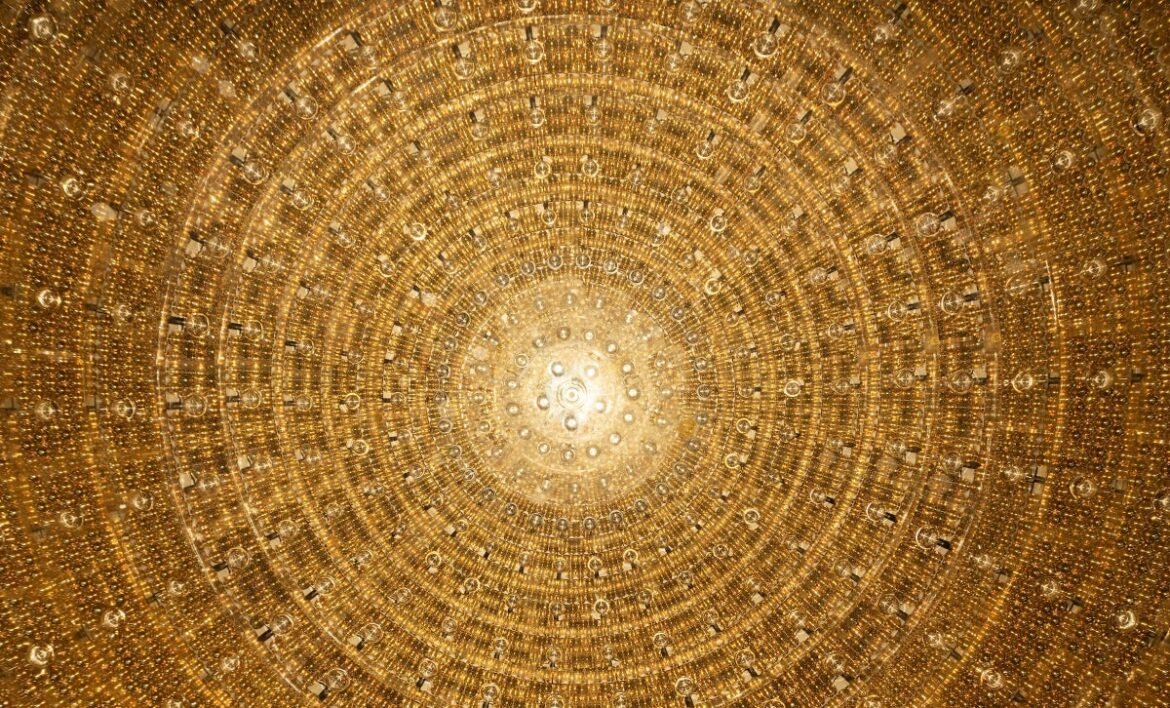November 26, 2025
2 min read
China’s Giant Underground Neutrino Observatory Just Released Its First Results—And They’re Promising
Hidden beneath the hills of southern China, the JUNO observatory shows promise in solving neutrino mysteries

JUNO’s central detector is filled with scintillating fluid and surrounded by photomultiplier tubes (shown here).
Yuexiang Liu/JUNO Collaboration
Trillions of neutrinos whiz through our bodies every day, pulsing from the sun, outer space and deep beneath Earth. Yet these elusive subatomic particles have proven difficult to study. That could soon change, however. Buried 700 meters beneath the rolling hills of southern China, an enormous neutrino observatory called JUNO has released its first results after a mere 59 days of operation. And so far, they are very promising, physicists say.
“The physics result is already world-leading in the areas that it touches,” says particle physicist Juan Pedro Ochoa-Ricoux of the University of California, Irvine, who co-leads a team on JUNO.
“In particular, we measured two neutrino oscillation parameters, and that measurement is already for both parameters the best in the world,” he says. The results were published in two separate preprints on arXiv.org.
On supporting science journalism
If you’re enjoying this article, consider supporting our award-winning journalism by subscribing. By purchasing a subscription you are helping to ensure the future of impactful stories about the discoveries and ideas shaping our world today.
JUNO—short for Jiangmen Underground Neutrino Observatory—has been tasked with a tall order: determine the ordering of masses of the three types of neutrino. In other words, do they follow a “normal mass ordering,” where the first flavor of neutrino is the lightest and the third the heaviest, or an inverted one, in which the third neutrino mass state is the lightest?
The answer to this question holds myriad implications, from informing other experiments to uncovering new physics to explaining certain cosmological mysteries. That’s because despite being such lightweights, neutrinos are so incredibly numerous that they may play an outsized role in the distribution of matter in the universe.
JUNO’s spherical detector, which is akin to a 13-story-tall fishbowl, primarily measures so-called electron antineutrinos spewing from the nearby Yangjian and Taishan nuclear plants. When the particles strike a proton inside the detector, a reaction triggers two light flashes that ping photomultiplier tubes and get converted into electrical signals.
The new measurements from these neutrino-proton collisions are now considered the most precise for two oscillation parameters, which act as proxies for differences in their mass, according to Ochoa-Ricoux.
“It is the first time we’ve turned on a scientific instrument like JUNO that we’ve been working on for over a decade. It’s just tremendously exciting,” Ochoa-Ricoux says. “And then to see that we’re able to already do world-leading measurements with it, even with such a small amount of data, that’s also really exciting.”
Still, the physicists will need years’ worth of neutrino detections to answer the mass-ordering conundrum.
It’s Time to Stand Up for Science
If you enjoyed this article, I’d like to ask for your support. Scientific American has served as an advocate for science and industry for 180 years, and right now may be the most critical moment in that two-century history.
I’ve been a Scientific American subscriber since I was 12 years old, and it helped shape the way I look at the world. SciAm always educates and delights me, and inspires a sense of awe for our vast, beautiful universe. I hope it does that for you, too.
If you subscribe to Scientific American, you help ensure that our coverage is centered on meaningful research and discovery; that we have the resources to report on the decisions that threaten labs across the U.S.; and that we support both budding and working scientists at a time when the value of science itself too often goes unrecognized.
In return, you get essential news, captivating podcasts, brilliant infographics, can’t-miss newsletters, must-watch videos, challenging games, and the science world’s best writing and reporting. You can even gift someone a subscription.
There has never been a more important time for us to stand up and show why science matters. I hope you’ll support us in that mission.



